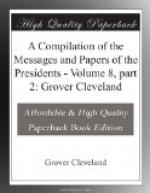No material change has taken place within the last year in the condition and prospects of the Indian tribes who reside in the Northwestern Territory and west of the Mississippi River. We are at peace with all of them, and it will be a source of pleasure to you to learn that they are gradually advancing in civilization and the pursuits of social life.
Along the Mexican frontier and in California and Oregon there have been occasional manifestations of unfriendly feeling and some depredations committed. I am satisfied, however, that they resulted more from the destitute and starving condition of the Indians than from any settled hostility toward the whites. As the settlements of our citizens progress toward them, the game, upon which they mainly rely for subsistence, is driven off or destroyed, and the only alternative left to them is starvation or plunder. It becomes us to consider, in view of this condition of things, whether justice and humanity, as well as an enlightened economy, do not require that instead of seeking to punish them for offenses which are the result of our own policy toward them we should not provide for their immediate wants and encourage them to engage in agriculture and to rely on their labor instead of the chase for the means of support.
Various important treaties have been negotiated with different tribes during the year, by which their title to large and valuable tracts of country has been extinguished, all of which will at the proper time be submitted to the Senate for ratification.
The joint commission under the treaty of Guadalupe Hidalgo has been actively engaged in running and marking the boundary line between the United States and Mexico. It was stated in the last annual report of the Secretary of the Interior that the initial point on the Pacific and the point of junction of the Gila with the Colorado River had been determined and the intervening line, about 150 miles in length, run and marked by temporary monuments. Since that time a monument of marble has been erected at the initial point, and permanent landmarks of iron have been placed at suitable distances along the line.
The initial point on the Rio Grande has also been fixed by the commissioners, at latitude 32 deg. 22’, and at the date of the last communication the purvey of the line had been made thence westward about 150 miles to the neighborhood of the copper mines.
The commission on our part was at first organized on a scale which experience proved to be unwieldy and attended with unnecessary expense. Orders have therefore been issued for the reduction of the number of persons employed within the smallest limits consistent with the safety of those engaged in the service and the prompt and efficient execution of their important duties.




